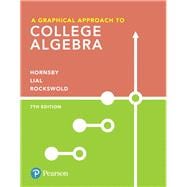For courses in college algebra.
Unifies the theme of a function – See, Solve, Apply
The Graphical Approach series by Hornsby, Lial, and Rockswold covers functions through a consistent, four-part analytical process. The authors ask students to:
1: [See] Examine the nature of the graph
2: Solve a typical equation analytically and graphically
3: Solve the related inequality analytically and graphically
4: Apply analytic and graphical methods to solve an application
This proven approach helps students gain a deep visual and graphical understanding of math, solidifying a stronger connection to the mathematical world around them.
Also available with MyLab Math
MyLab™ Math is the teaching and learning platform that empowers instructors to reach every student. By combining trusted author content with digital tools and a flexible platform, MyLab personalizes the learning experience and improves results for each student.
Note: You are purchasing a standalone product; MyLab Math does not come packaged with this content. Students, if interested in purchasing this title with MyLab Math, ask your instructor to confirm the correct package ISBN and Course ID. Instructors, contact your Pearson representative for more information.
If you would like to purchase both the physical text and MyLab Math search for:
0134851064 / 9780134851068 A Graphical Approach to College Algebra Plus MyLab Math with Pearson eText -- Access Card Package, 7/e
Package consists of:
0134696522 / 9780134696522 A Graphical Approach to College Algebra
0134859227 / 9780134859224 MyLab Math with Pearson eText - Standalone Access Card - for A Graphical Approach to College Algebra









